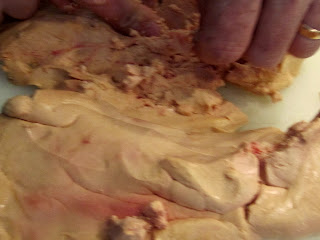As everyone who loves foie gras already knows, it became illegal in California last year:( For those of you who are vegetarians or support the ban, please stop reading. Anyone still reading may want to go get a bib now:)
One of the things I love about living here is that daily shopping at the bakery, butcher, and produce market, all create human connections that form the community. I see the same people several times a week and when I finally choose the merchants I like for my food, bonds develop which go beyond commerce. My sausage lady knows the entire family from Sweden. The cheesemonger knows the ripeness required for a repast that evening. The fruit guy knows I love clementines. The bakery knows when I come in that I want one well done baguette tradition.
My friends have lived here for nearly 40 years and are still considered "new" compared to the families who have been here since the time royalty ruled. Forty years of connections means that even when their favorite butcher retired, they remained in contact, and since I've been friends with them for over 30 years, I was treated to a private lesson in their home by a professional butcher on how to make foie gras!
The first part of the lesson was choosing what to buy. It should look like this:
Note that it must be labeled "Indication Géographique Protégéé" to truly be foie gras. It's like a stamp of authenticity, because without it, the foie could have come from China and merely packaged in France. It should also never be more than 700 grams or 1.5 pounds each because if it weighs more, it was probably treated with hormones or injected with something. We had two foies for a total of 60 € (I compared prices at Galeries Lafayette and found he gave us a wholesale price because retail was double this cost) or about $90 to make a terrine that would easily serve 12, so it's about $8 per serving.
The butcher brought everything from the porcelain terrine to the white port and white pepper.
The first thing he did was slice open the packages of raw foie and let them come to room temperature while having a coffee. Have I already mentioned how life here is slower and people take their time? It's a challenge when waiting for repairs, returns, and deliveries, but it's a welcome change when it comes to cooking and eating.
Once we finished our coffee, we took the two foies out of their packages and got an anatomy lesson in how the veins run through the livers. The butcher warned us against buying deveined foie because as you will see later, if you don't buy the actual foie in one piece, anything can be made to look like deveined foie. Carefully spreading open the foie, the butcher, Monsieur Rocher, pointed out the biggest part of the vein at the top of the picture.
Spreading out the interior with his fingers like clay, Monsieur Rocher started at the top of the vein and gently pulled out the rest. It was a bit like taking out fish bones from the head to the tail, except this was much messier and more delicate. My friend put on rubber gloves to keep the foie from going into her nails, but the butcher said, it's better to do it with bare hands so you can feel the veins as you do this.
The veins from one of the foie.
By the time all the veins were removed, the foie looked like blocks of clay.
Because they were at room temperature, they were as soft as cookie dough.
The next step was to season liberally with white pepper, salt and the white port.
Once seasoned, the butcher rolled up the foie gras like you would a jelly roll and put it into the terrine he brought.
Cleaning up the edges with a paper towel, and smoothing out the top with the back of a spoon, we were ready to put the prepared terrine into a bain marie (a bigger pan halfway filled with hot water).
Then into a convection oven for 15 minutes at 160C or 320F on a rack set at mid or low, whichever makes the top of the terrine top reach the middle of the oven.
That's it. Once you remove the terrine, spoon the fat evenly over the top so when it sets you will have an even coating on top. Let it cool near an open window until the terrine is room temperature, then cover with plastic film and refrigerate until you want to serve it. It will keep for about a week, so we are eating this for Christmas:) When you are ready to serve, take it out 20 minutes before serving and run the bottom and sides of the terrine with warm water, or dip the terrine into a bain marie, and a warm a sharp knife with hot water water. Slice and eat!














No comments:
Post a Comment